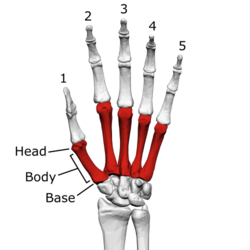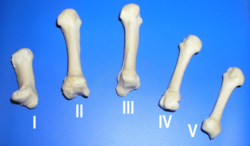Metacarpal bones
This article does not have any sources. (June 2009) |
The metacarpus is the intermediate part of the hand skeleton. It is between the phalanges (bones of the fingers) distally and the carpals which form the connection to the forearm. The metacarpus consists of metacarpal bones.
| Metacarpal bones | |
|---|---|
 Metacarpals shown in red. Left hand, anterior (palmar) view. | |
 The five metacarpal bones, numbered. Left hand, anterior (palmar) view. | |
| Details | |
| Origins | Carpal bones of wrist |
| Insertions | Proximal phalanges |
| Articulations | Carpometacarpal, intermetacarpal, metacarpophalangeal |
| Identifiers | |
| Latin | ossa metacarpalia |
| MeSH | D050279 |
| TA | A02.4.09.001 |
| FMA | 9612 |
| Anatomical terms of bone | |
Metacarpal, any of several tubular bones between the wrist (carpal) bones and each of the forelimb digits in land vertebrates, corresponding to the metatarsal bones of the foot. Originally numbering five, metacarpals in many mammals have undergone much change and reduction during evolution. The lower leg of the horse, for example, includes only one strengthened metacarpal; the two splint bones behind and above the hoof are reduced metacarpals, and the remaining two original metacarpals have been lost. In humans the five metacarpals are flat at the back of the hand and bowed on the palmar side; they form a longitudinal arch that accommodates the muscles, tendons, and nerves of the palm. The metacarpals also form a transverse arch that allows the fingertips and thumb to be brought together for manipulation.
carpal bone
changeCarpal bone, any of several small angular bones that in humans make up the wrist (carpus), and in horses, cows, and other quadrupeds the “knee” of the foreleg. They correspond to the tarsal bones of the rear or lower limb. Their number varies. Primitive vertebrates typically had 12. In modern amphibians, reptiles, and birds, the number is reduced by fusion. In humans there are eight, arranged in two rows. The bones in the row toward the forearm are the scaphoid, lunate, triangular, and pisiform. The row toward the fingers, or distal row, includes the trapezium (greater multangular), trapezoid (lesser multangular), capitate, and hamate. The distal row is firmly attached to the metacarpal bones of the hand. The proximal row articulates with the radius (of the forearm) and the articular disk (a fibrous structure between the carpals and malleolus of the ulna) to form the wrist joint.(Healthvoce)